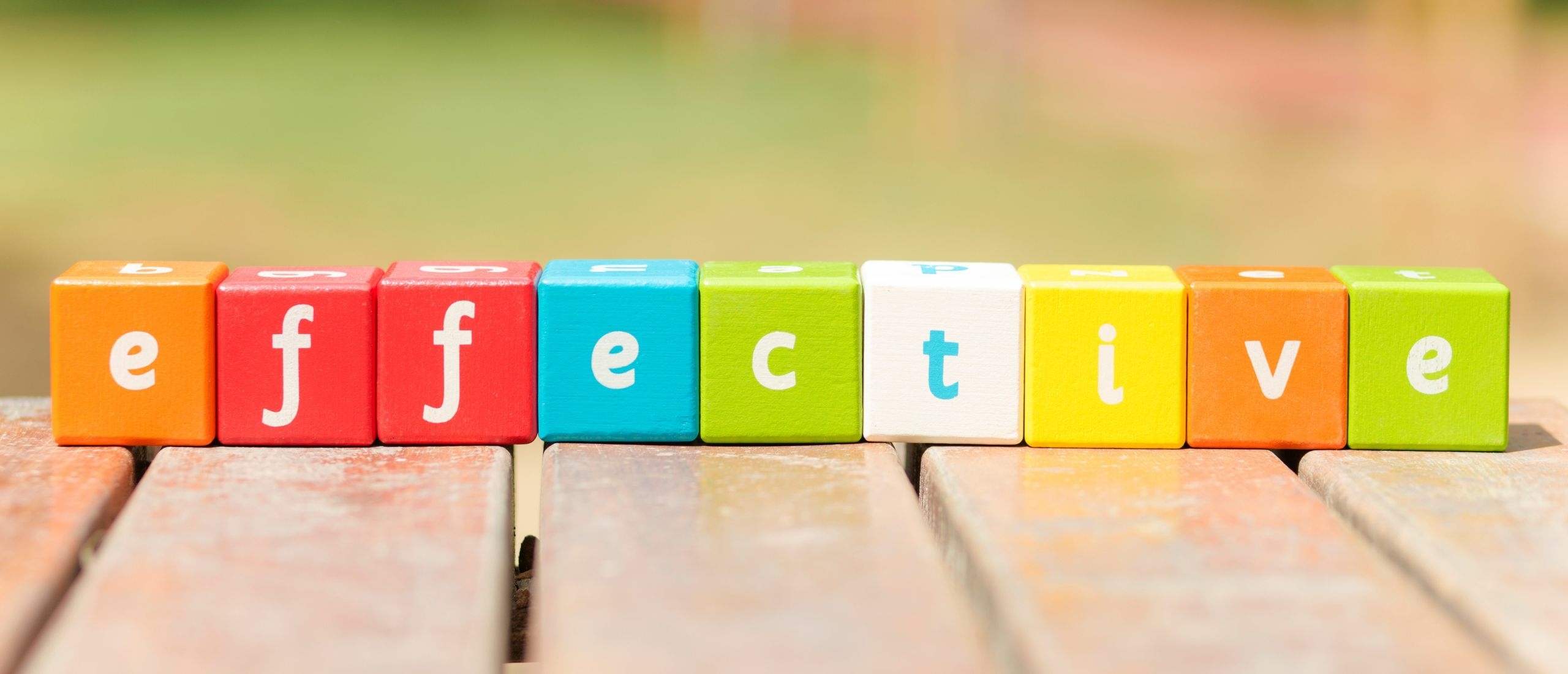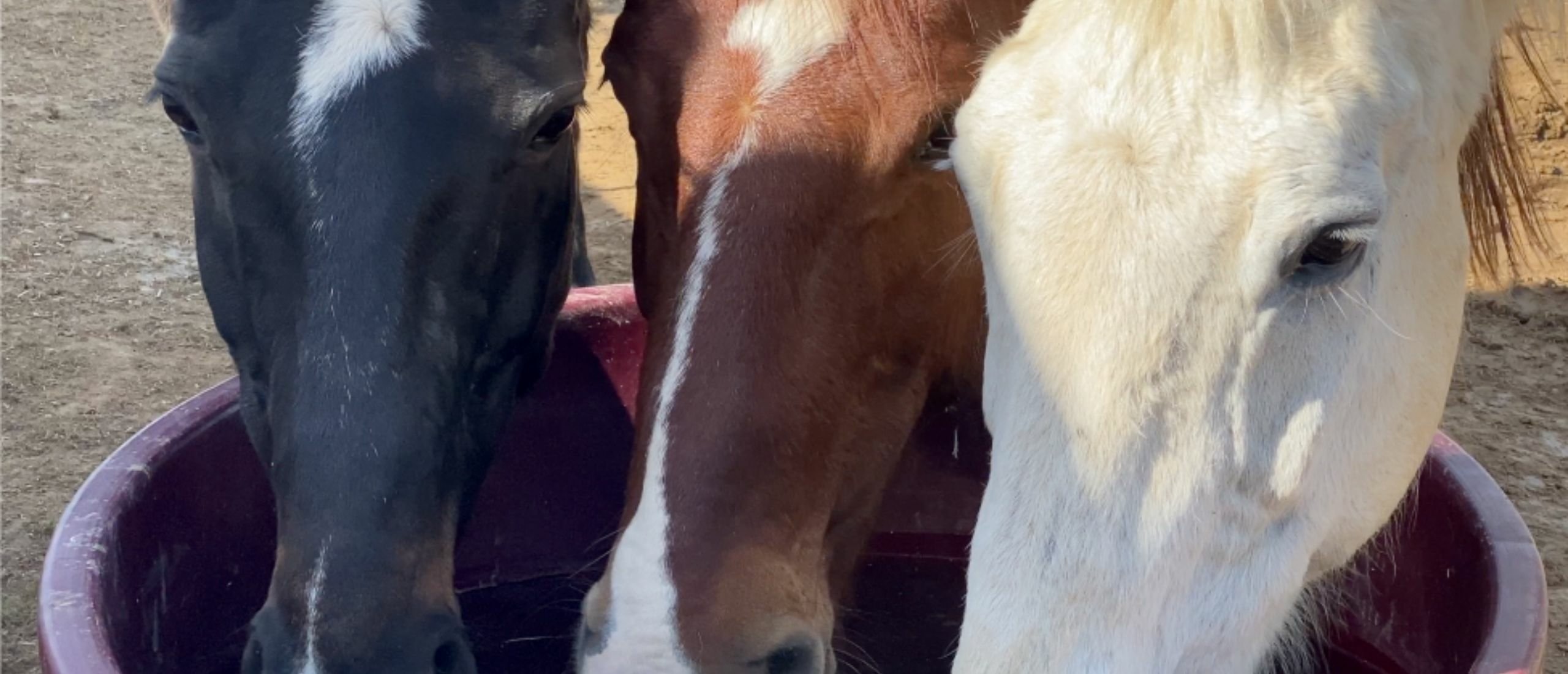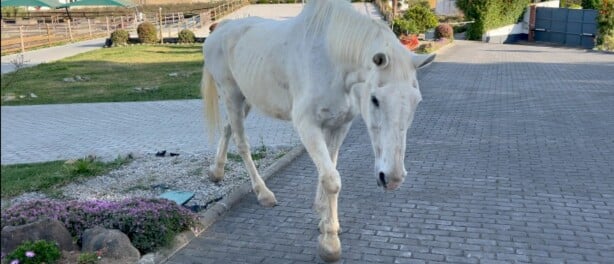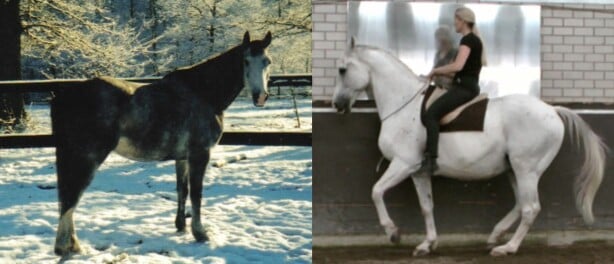After a couple of weeks of groundwork and longeing, we did an
observing session at liberty:
- It showed that Prince Elmelund is mentally seen ready to deliver.
- But physically seen, he still lacks the muscles and core strength after 10 months of holidays and a bit of training.
Now when it comes to
self-carriage, we need it both in body and mind. And it's a bit the chicken and the egg,
what is needed first? Well, it doesn't matter what came first,
we need both! This means:
- The liberty work will get better physically seen, once the self-carriage in the body is developed in groundwork, longeing, work in hand, and riding pillar.
- And those other 4 pillars will get better mentally seen, once our horse gives his Best Aikido at liberty, expressing self-carriage in the mind.
Now with is self-carriage in the mind exactly?
Self Carriage In The Mind
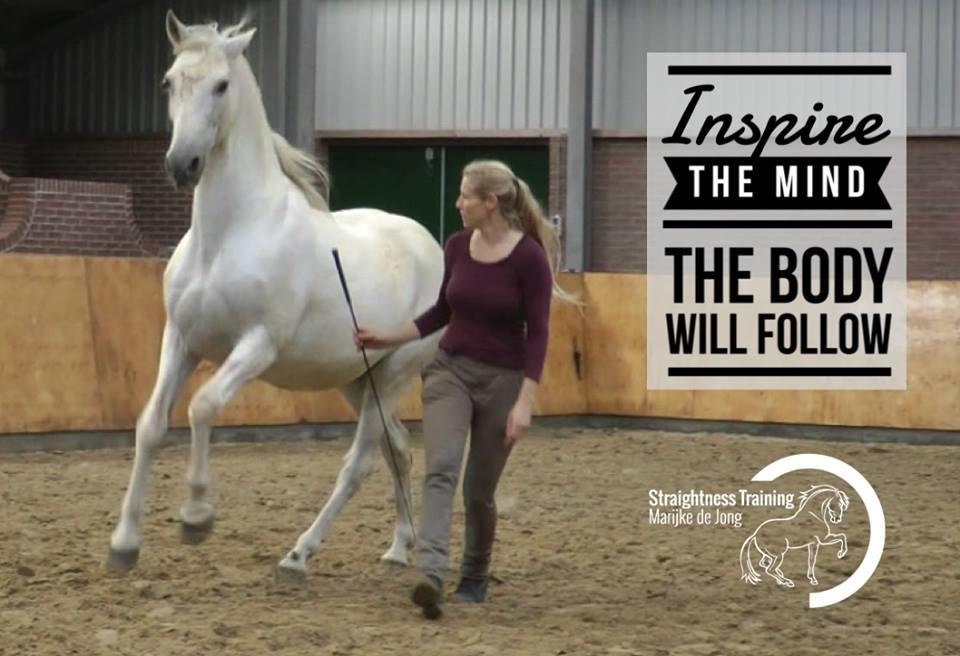
The main reason why Liberty has been added as the fifth pillar to ST is:
- To refine the skills of the rider.
- To help riders to reach more with less aids.
- To 'force' riders to encourage their horse to think about the actual behavior he has to do and to take responsibility for it.
Now this self-carriage in the mind
relies on understanding and motivation, because if our horse:
- doesn't have an understanding about the behavior he has to offer such as trot, canter, haunches-in, piaffe,
- and/or isn't motivated to offer this behavior by himself
we have to 'make' him do it with our aids... And then our horse will act as a sort of
non-thinking 'puppet on a string', acting from a
low mental state, displaying no self-carriage in the mind. It also leads to
less with more: The More You Use The Reins, The Less They Will Use Their Brains
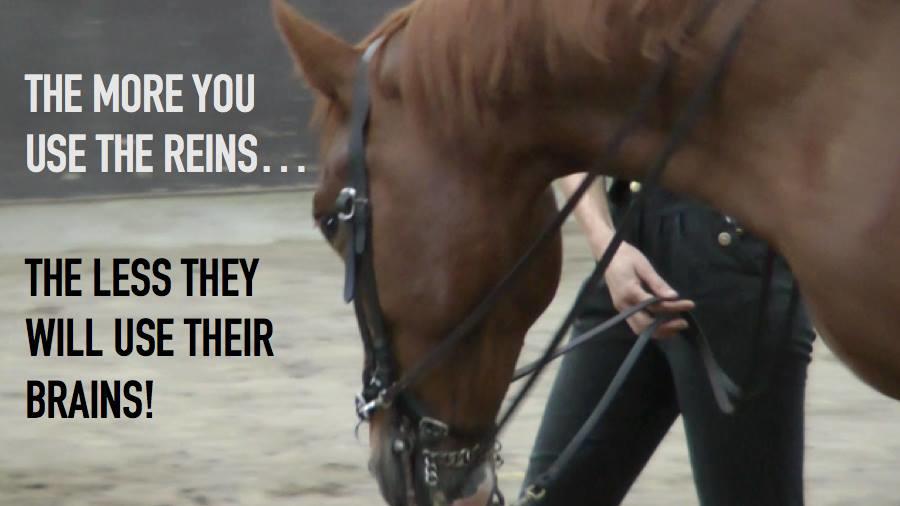
This is a popular and
very wise saying in natural horsemanship. It means, that if we use the reins too much, too often, or too long,
our horse will start to think less and less about the actual behavior he has to offer. Because when using the reins too much, too often, too long his
reptilian (survival) brain will take over. That means,
he will only be thinking about: - How to avoid the rein pressure - causing a state of flight in the form of going behind the bit, avoiding any contact.
- How to get rid of the rein pressure - causing a state of fight in the form of nipping, biting, grabbing the reins.
In both cases, he will NOT think about the actual behavior he has to offer such as, for example, bringing the shoulders in or the haunches in. That's why with some people the use of pressure and '
negative reinforcement' as training technique has fallen into
discredit, and some riders 'warn' against it in favor of '
positive reinforcement'. But I believe, that's often because 'negative reinforcement' easily merges unconsciously into '
positive punishment' when we are dealing with the Biggest Handicap of a Human Being:
The Biggest Handicap Of A Human Being
As predators, we are very good at
grabbing, catching, holding, grasping, snatching, pushing, and pulling with our hands. As a result, we are experts in applying too much, too long, too often, sudden, and steady pressure.
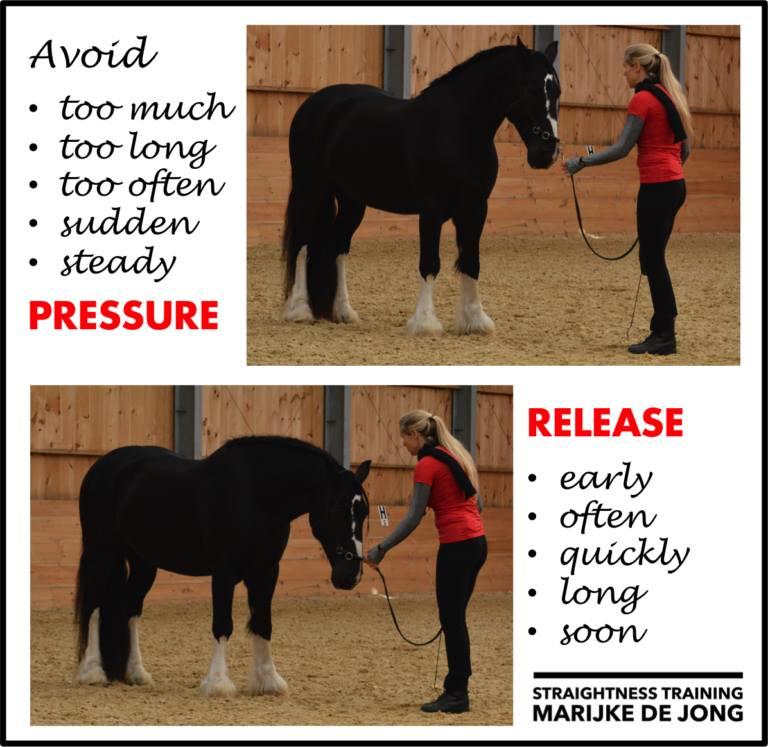
However, our horse will perceive that as
positive punishment and
opposed behavior, and experience it as if we're out to get him. In return,
he will start to 'defend' himself by going somewhere on the spectrum of either fight or flight. Now applying an '
avoidance strategy' and bypass these symptoms is an option. But in ST we don't teach our students how to avoid their problems, but
how to deal with the root of their problem. And we do so by
changing ourselves first. That's why we start
Expedition Zero in the ST Pyramid. There we learn that when using the reins
the release is most important - not the application of pressure. And when it comes to pressure we learn why we use it, and how much, how long, how fast, where,
when, and when to quit. And once our timing and dosing of the rein aids are okay - both in pressure and release - the reins are a perfect tool for
refinement so we can help our horse to find
self-carriage in the body more quickly and efficiently.
Self-Carriage In The Body
Straightness Training is about teaching our horse
gymnastic exercises, and those exercises will help him:
- To counteract the natural asymmetry and natural balance.
- To develop our horse towards riding balance so he can carry us properly and in a healthy way.
So by teaching our horse those exercises, we can a sort of 'shape' our horse:
- First, we help him to find the proper lateral bend, and we ask him to move into forward down, plus, to step under with the inside hind leg.
- Then we ask him to bring his shoulders in.
- Next his haunches-in.
- Then we shift his center of mass direction his hind legs, and as a result, we develop artificial balance and self-carriage, where the horse is able to carry most weight on the hind legs.
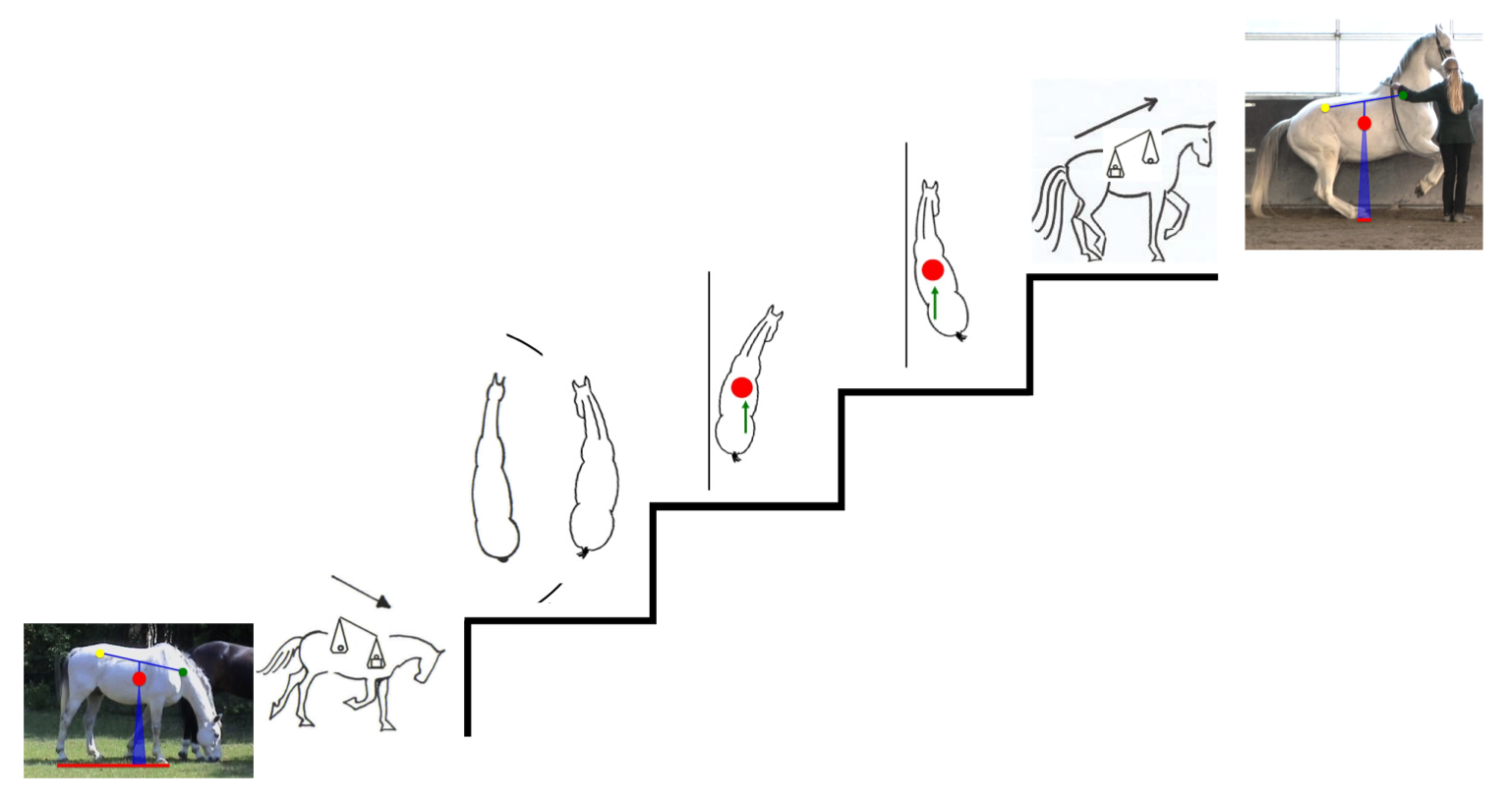
Now for sure, we can school our horse all the way up to self-carriage in the body with the
liberty pillar only. That means, we can reach it perfectly
without the use of the other pillars, which are groundwork, longeing, work in hand, and riding. In a way, we can train our horse
as if he was a sort of marine animal such as a dolphin, orca, seal, or sea lion. Which means:
without physical touch, guidance, and pressure. In other words:
without the use of seat, leg and rein aids. But in ST, we believe this is
not the most productive way of training. Because when doing Straightness Training, two things are important:
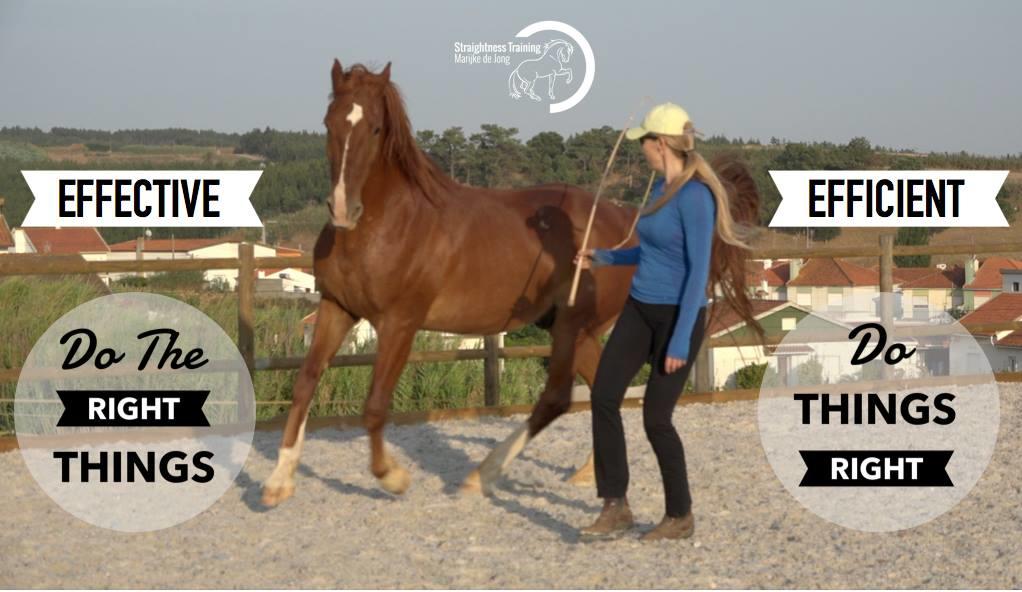
1. Train Effectively
Which simply said means:
Then end result will be right and
useful. So in ST, we do not only train our horse just to train him, so with a sort of
lack of purpose. That means, being able to do STuff at the highest levels at
liberty is not a goal in itself. It's a
mean to an end. Because, by only focussing on developing the fancy STuff at liberty, there's a chance that we a sort of
'lose' in the end or our journey:
- we might have lost sight of the essence along the way,
- ending up with look-a-likes.
Instead, focusing on the correct development of body and mind will lead to a
'win-win-win' situation:
- Our horse will be doing the right thing, which is doing the exercises with essence
- and the end result will be useful: he will be able to carry us in the right way,
- plus, a nice 'by-product' will be that he will look good with all his muscles and proud appearance.
So in ST, we always
train with the end goal in mind: - That our horse can carry us in a healthy and happy way, so we want to make our horse fully suitable for that job by helping him develop a muscular, strong, flexible, mobile, balanced body.
- That our horse is great company and a reliable working partner, so that we, for example, can go on a trail ride and do simple tasks such as opening of a gate, or making a little jump.
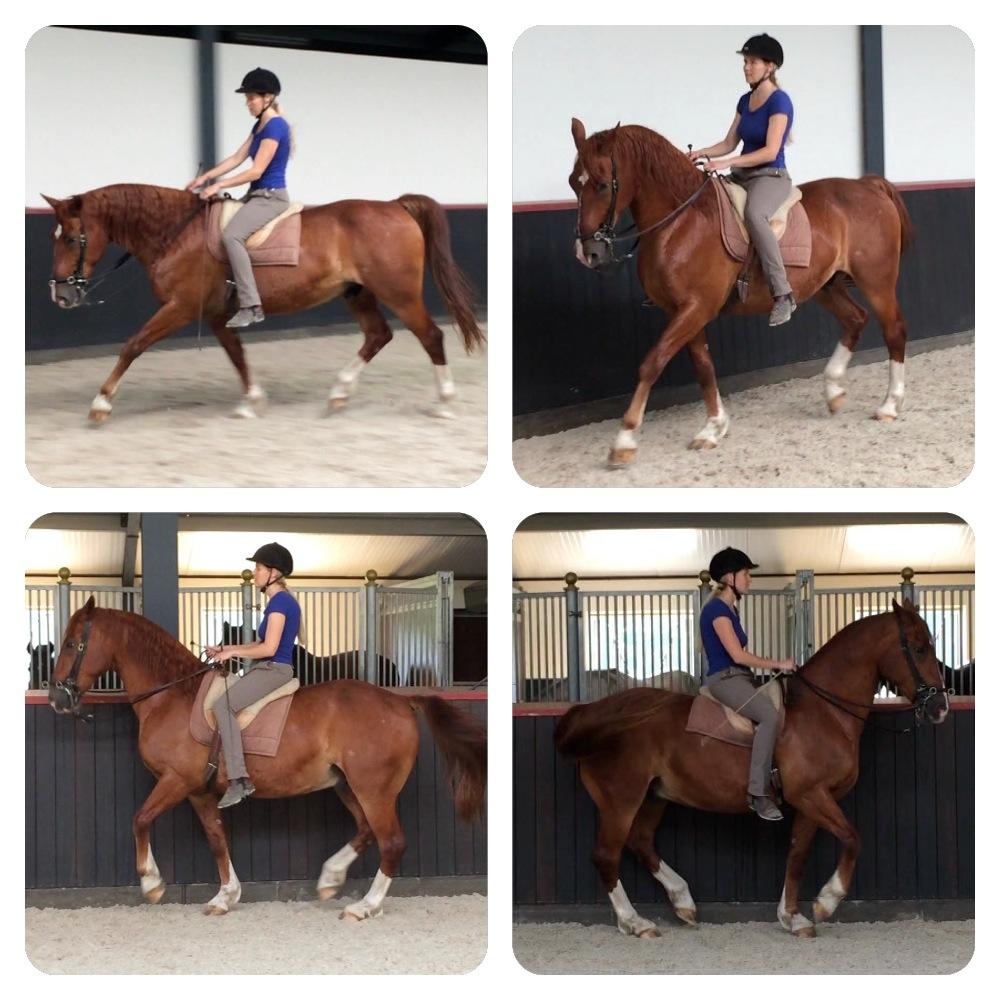
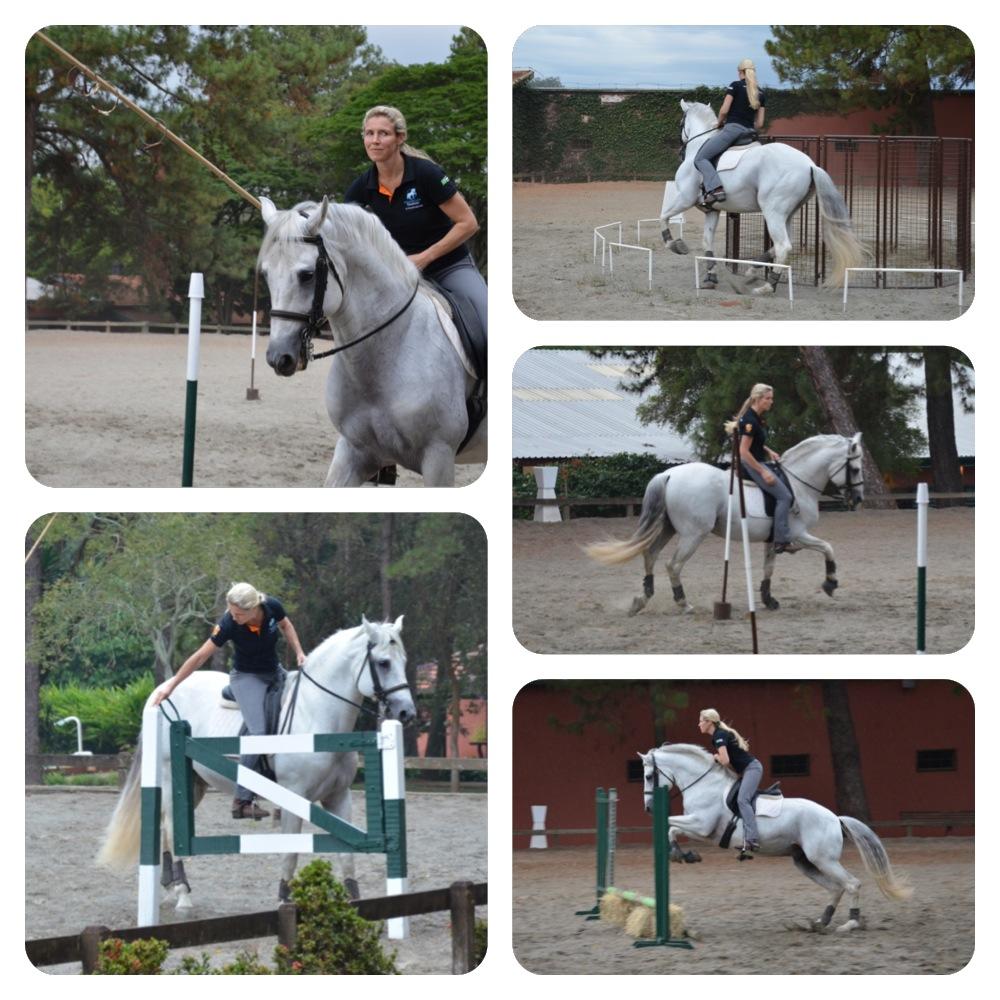
2. Train Efficiently
Which means:
And in the best possible manner with the
least waste of time and effort. Therefore, training our horse NOT only at liberty, and by guiding him with our touch, will
save us a lot of time. And our
horse is not a dolphin: A
dolphin is a predator - eating fishes like herring, cod, mackerel - and
our horse is a prey animal. Therefore, our horse is very sensitive to pressure because of his
flight instinct. Also, pressure and release are very visible in
herd dynamics: 
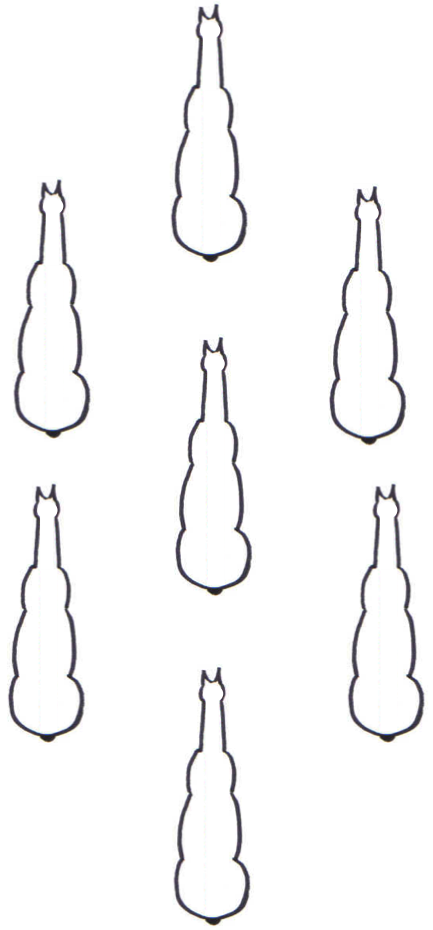
In a herd, we can see that
there's nobody more 'spot on' when it comes to pressure and release as the horse! That's why seat, leg, and rein aids are so
very easy to use and
easy to understand: We can use them as a
herd of aids, where are reins guide the front legs, our legs the hind legs, our focus the direction, and our energy the speed. But of course, our herd of aids
only work when we do. So we have to make sure to counteract our Biggest Handicap and our predator behavior - again, that's what
Expedition Zero in the ST Pyramid is all about. Then, when our timing and dosing is okay, we can continue with our expeditions:
- We can use our seat, leg, and rein aids in groundwork, longeing, work in hand, and riding without annoying our horse.
- So we can shape his body and help our horse to reach his full potential in an efficient way.
- While our horse remains an active and engaged learner, figuring out what we want, taking responsibility for his behavior, in the same way he does at liberty.
So in ST, we encourage our STudents to
use all five training pillars. With all five pillars in our toolkit, we can
train in an effective and efficient way. So back to Prince Elmelund: I will shift to another pillar -
work in hand. 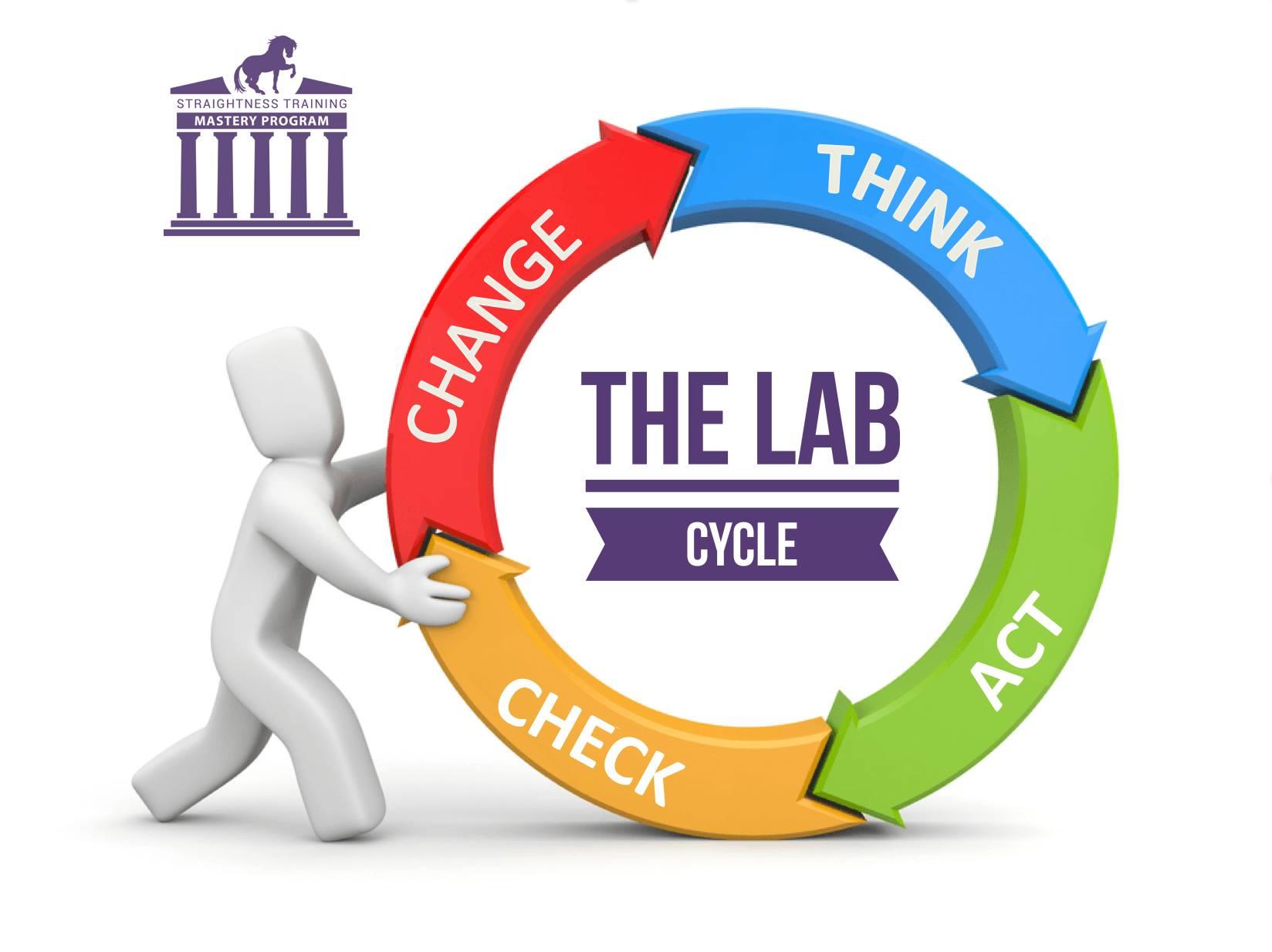
After doing groundwork, longeing and liberty, I will start working Prince Elmelund
in hand with the bridle for a while. And in that process, the art of training is the ability
to check and switch. So when I notice some lack of motivation or mental resistance in work in hand, I think
"uh-oh, I'm probably a bit too micromanaging with my reins" and return to liberty, to redirect myself and
change my approach. Then when PE is fresh in the mind again, I return to work in hand and then do
'as if' I work at liberty, only using the reins to refine his body. And then I return to liberty again to check and test if the work in hand helped him to improve his
self-carriage in the body. And so it goes in the ST Lab Cycle:
think, act, check, change... and repeat... until you get what you want ;-)
Links To Related Articles
 The main reason why Liberty has been added as the fifth pillar to ST is:
The main reason why Liberty has been added as the fifth pillar to ST is:  This is a popular and very wise saying in natural horsemanship. It means, that if we use the reins too much, too often, or too long, our horse will start to think less and less about the actual behavior he has to offer. Because when using the reins too much, too often, too long his reptilian (survival) brain will take over. That means, he will only be thinking about:
This is a popular and very wise saying in natural horsemanship. It means, that if we use the reins too much, too often, or too long, our horse will start to think less and less about the actual behavior he has to offer. Because when using the reins too much, too often, too long his reptilian (survival) brain will take over. That means, he will only be thinking about:  However, our horse will perceive that as positive punishment and opposed behavior, and experience it as if we're out to get him. In return, he will start to 'defend' himself by going somewhere on the spectrum of either fight or flight. Now applying an 'avoidance strategy' and bypass these symptoms is an option. But in ST we don't teach our students how to avoid their problems, but how to deal with the root of their problem. And we do so by changing ourselves first. That's why we start Expedition Zero in the ST Pyramid. There we learn that when using the reins the release is most important - not the application of pressure. And when it comes to pressure we learn why we use it, and how much, how long, how fast, where, when, and when to quit. And once our timing and dosing of the rein aids are okay - both in pressure and release - the reins are a perfect tool for refinement so we can help our horse to find self-carriage in the body more quickly and efficiently.
However, our horse will perceive that as positive punishment and opposed behavior, and experience it as if we're out to get him. In return, he will start to 'defend' himself by going somewhere on the spectrum of either fight or flight. Now applying an 'avoidance strategy' and bypass these symptoms is an option. But in ST we don't teach our students how to avoid their problems, but how to deal with the root of their problem. And we do so by changing ourselves first. That's why we start Expedition Zero in the ST Pyramid. There we learn that when using the reins the release is most important - not the application of pressure. And when it comes to pressure we learn why we use it, and how much, how long, how fast, where, when, and when to quit. And once our timing and dosing of the rein aids are okay - both in pressure and release - the reins are a perfect tool for refinement so we can help our horse to find self-carriage in the body more quickly and efficiently.  Now for sure, we can school our horse all the way up to self-carriage in the body with the liberty pillar only. That means, we can reach it perfectly without the use of the other pillars, which are groundwork, longeing, work in hand, and riding. In a way, we can train our horse as if he was a sort of marine animal such as a dolphin, orca, seal, or sea lion. Which means: without physical touch, guidance, and pressure. In other words: without the use of seat, leg and rein aids. But in ST, we believe this is not the most productive way of training. Because when doing Straightness Training, two things are important:
Now for sure, we can school our horse all the way up to self-carriage in the body with the liberty pillar only. That means, we can reach it perfectly without the use of the other pillars, which are groundwork, longeing, work in hand, and riding. In a way, we can train our horse as if he was a sort of marine animal such as a dolphin, orca, seal, or sea lion. Which means: without physical touch, guidance, and pressure. In other words: without the use of seat, leg and rein aids. But in ST, we believe this is not the most productive way of training. Because when doing Straightness Training, two things are important: 



 In a herd, we can see that there's nobody more 'spot on' when it comes to pressure and release as the horse! That's why seat, leg, and rein aids are so very easy to use and easy to understand: We can use them as a herd of aids, where are reins guide the front legs, our legs the hind legs, our focus the direction, and our energy the speed. But of course, our herd of aids only work when we do. So we have to make sure to counteract our Biggest Handicap and our predator behavior - again, that's what Expedition Zero in the ST Pyramid is all about. Then, when our timing and dosing is okay, we can continue with our expeditions:
In a herd, we can see that there's nobody more 'spot on' when it comes to pressure and release as the horse! That's why seat, leg, and rein aids are so very easy to use and easy to understand: We can use them as a herd of aids, where are reins guide the front legs, our legs the hind legs, our focus the direction, and our energy the speed. But of course, our herd of aids only work when we do. So we have to make sure to counteract our Biggest Handicap and our predator behavior - again, that's what Expedition Zero in the ST Pyramid is all about. Then, when our timing and dosing is okay, we can continue with our expeditions:  After doing groundwork, longeing and liberty, I will start working Prince Elmelund in hand with the bridle for a while. And in that process, the art of training is the ability to check and switch. So when I notice some lack of motivation or mental resistance in work in hand, I think "uh-oh, I'm probably a bit too micromanaging with my reins" and return to liberty, to redirect myself and change my approach. Then when PE is fresh in the mind again, I return to work in hand and then do 'as if' I work at liberty, only using the reins to refine his body. And then I return to liberty again to check and test if the work in hand helped him to improve his self-carriage in the body. And so it goes in the ST Lab Cycle: think, act, check, change... and repeat... until you get what you want ;-)
After doing groundwork, longeing and liberty, I will start working Prince Elmelund in hand with the bridle for a while. And in that process, the art of training is the ability to check and switch. So when I notice some lack of motivation or mental resistance in work in hand, I think "uh-oh, I'm probably a bit too micromanaging with my reins" and return to liberty, to redirect myself and change my approach. Then when PE is fresh in the mind again, I return to work in hand and then do 'as if' I work at liberty, only using the reins to refine his body. And then I return to liberty again to check and test if the work in hand helped him to improve his self-carriage in the body. And so it goes in the ST Lab Cycle: think, act, check, change... and repeat... until you get what you want ;-) 
